-
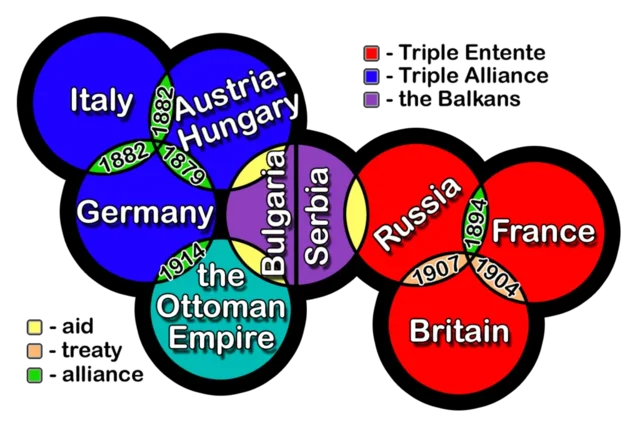 The development of alliances before WWI was crucial because it created two powerful groups that clashed with each other during WWI. The alliances increased the likelihood of dragging allies into conflicts, then escalate to a global conflict. The main alliances were the Triple Alliance, which included Germany, Austria-Hungary, and Italy. The other alliance is the Triple Entente, which included France, Russia, and Britain.
The development of alliances before WWI was crucial because it created two powerful groups that clashed with each other during WWI. The alliances increased the likelihood of dragging allies into conflicts, then escalate to a global conflict. The main alliances were the Triple Alliance, which included Germany, Austria-Hungary, and Italy. The other alliance is the Triple Entente, which included France, Russia, and Britain. -
 The assassination of Archduke Franz Ferdinand on June 28, 1914, was a crucial event that set off a chain reaction leading to World War I. As the heir to the throne, his death created a major political crisis between Austria-Hungary and Serbia,then other countries in Europe. This event was important because the assassination sparked conflict that escalated into a war.
The assassination of Archduke Franz Ferdinand on June 28, 1914, was a crucial event that set off a chain reaction leading to World War I. As the heir to the throne, his death created a major political crisis between Austria-Hungary and Serbia,then other countries in Europe. This event was important because the assassination sparked conflict that escalated into a war. -
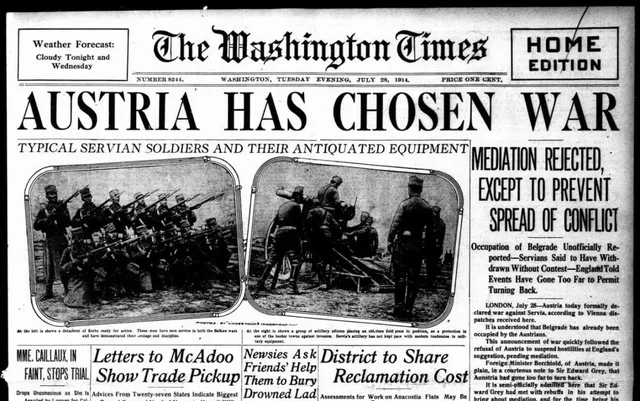 Austria-Hungary’s declaration of war on Serbia in July 1914 triggered the start of World War I. Russia, allied with Serbia, began summoning its army to defefend the country. For Germany, Austria-Hungary’s ally, declared war on Russia. Germany then attacked France, Russia’s ally, by invading Belgium and Luxembourg, which brought Britain into the conflict. What began as a local conflict quickly escalated into a full-scale global war.
Austria-Hungary’s declaration of war on Serbia in July 1914 triggered the start of World War I. Russia, allied with Serbia, began summoning its army to defefend the country. For Germany, Austria-Hungary’s ally, declared war on Russia. Germany then attacked France, Russia’s ally, by invading Belgium and Luxembourg, which brought Britain into the conflict. What began as a local conflict quickly escalated into a full-scale global war. -
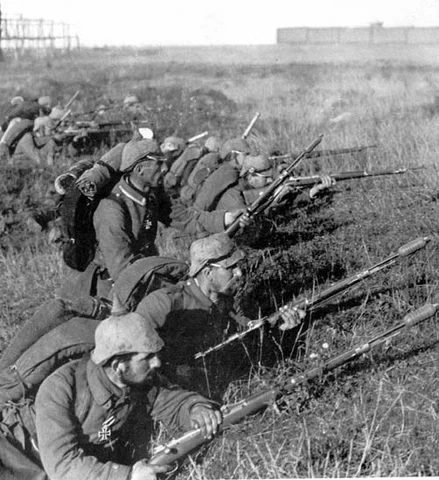 The Battle Of Marne as fought on September 6, 1914. This battle was very significant during World War I because it marked the end of Germany's invasion of France and stopped the Schlieffen Plan, Germany's military strategy during World War I. This battle was sucessful to the Allied Forces because they pushed Germany back. This battle led to the start of trench warfare, a type of combat where soldiers battle in deep trenches dug in the ground.
The Battle Of Marne as fought on September 6, 1914. This battle was very significant during World War I because it marked the end of Germany's invasion of France and stopped the Schlieffen Plan, Germany's military strategy during World War I. This battle was sucessful to the Allied Forces because they pushed Germany back. This battle led to the start of trench warfare, a type of combat where soldiers battle in deep trenches dug in the ground. -
 The Stalemate of the Trench Warfare occured in World War I, beggining in the late summer of 1914. It happened because the use of weapons and machine guns on both armies made it difficult to advance without losses of military. To protect themselves in the military view, they dug a system of deep trenches resulting in a stalemate. This lead on for four years.
The Stalemate of the Trench Warfare occured in World War I, beggining in the late summer of 1914. It happened because the use of weapons and machine guns on both armies made it difficult to advance without losses of military. To protect themselves in the military view, they dug a system of deep trenches resulting in a stalemate. This lead on for four years. -
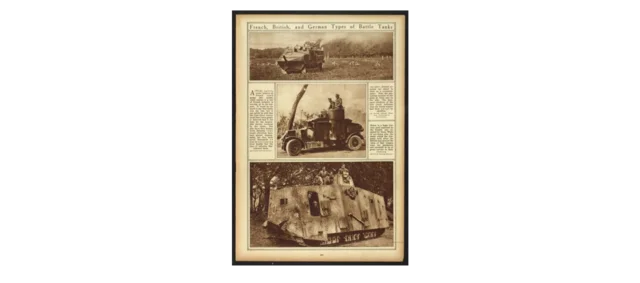 In World War I, some technology that were used were the Machine Gun, Tanks, Airplanes in combat, and Chemical Weapons. Firstly, the Machine gun could fire rapidly, killing many soldiers at once. Secondly, Tanks were introduced by the British in 1916 and were used to help soldiers cross enemy territory. Thirdly, Airplanes and boats were used in war to support attack. Lastly, Chemical weapons were used like poison gas was used in World War I, and it caused more danger to soldiers.
In World War I, some technology that were used were the Machine Gun, Tanks, Airplanes in combat, and Chemical Weapons. Firstly, the Machine gun could fire rapidly, killing many soldiers at once. Secondly, Tanks were introduced by the British in 1916 and were used to help soldiers cross enemy territory. Thirdly, Airplanes and boats were used in war to support attack. Lastly, Chemical weapons were used like poison gas was used in World War I, and it caused more danger to soldiers. -
 The sinking of the Lusitania on May 7, 1915, was important because it resulted in the deaths of over 1,000 civilians, including 128 Americans, which fueled outrage in the United States. The attack highlighted the dangers of unrestricted submarine warfare and increased tensions between Germany and neutral nations. This event helped shift public opinion and brought the U.S. closer to entering World War I. The Lusitania was sunk by a german U boat, a torpedo.
The sinking of the Lusitania on May 7, 1915, was important because it resulted in the deaths of over 1,000 civilians, including 128 Americans, which fueled outrage in the United States. The attack highlighted the dangers of unrestricted submarine warfare and increased tensions between Germany and neutral nations. This event helped shift public opinion and brought the U.S. closer to entering World War I. The Lusitania was sunk by a german U boat, a torpedo. -
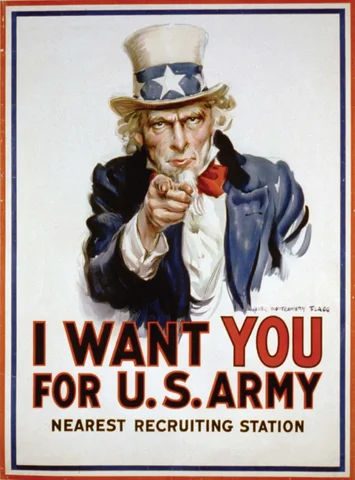 The United States entered World War I in April 1917 under President Woodrow Wilson. Initially, Wilson tried to keep the nation neutral, but repeated German attacks on American and Allied ships like the Lusitania, angered the public. That caused Woodrew Wilson to declare war on Germany. When the United States entered the war in April 1917, it provided fresh troops, resources, and financial support to the exhausted Allied forces. U.S helped boost the allied powers to win the war.
The United States entered World War I in April 1917 under President Woodrow Wilson. Initially, Wilson tried to keep the nation neutral, but repeated German attacks on American and Allied ships like the Lusitania, angered the public. That caused Woodrew Wilson to declare war on Germany. When the United States entered the war in April 1917, it provided fresh troops, resources, and financial support to the exhausted Allied forces. U.S helped boost the allied powers to win the war. -
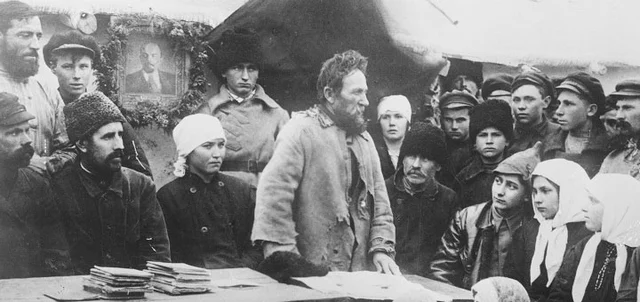 Russia exited World War I because it was facing severe military defeats, economic hardship, and widespread unrest among its people. The February Revolution of 1917 overthrew Tsar Nicholas II, and later that year, the Bolsheviks seized power promising peace. To fulfill this promise, they signed the Treaty of Brest-Litovsk in March 1918, officially ending Russia’s involvement in the war.
Russia exited World War I because it was facing severe military defeats, economic hardship, and widespread unrest among its people. The February Revolution of 1917 overthrew Tsar Nicholas II, and later that year, the Bolsheviks seized power promising peace. To fulfill this promise, they signed the Treaty of Brest-Litovsk in March 1918, officially ending Russia’s involvement in the war. -
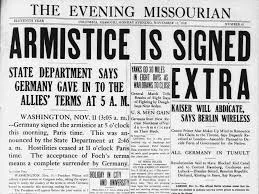 The Armistice of 11 November 1918 officially ended fighting on the Western Front in World War I. Germany agreed to cease hostilities, evacuate occupied territories, and surrender large amounts of military equipment to the Allies. This marked the victory of the Allied Powers—including France, the United Kingdom, and the United States—over the Central Powers, primarily Germany.
The Armistice of 11 November 1918 officially ended fighting on the Western Front in World War I. Germany agreed to cease hostilities, evacuate occupied territories, and surrender large amounts of military equipment to the Allies. This marked the victory of the Allied Powers—including France, the United Kingdom, and the United States—over the Central Powers, primarily Germany.